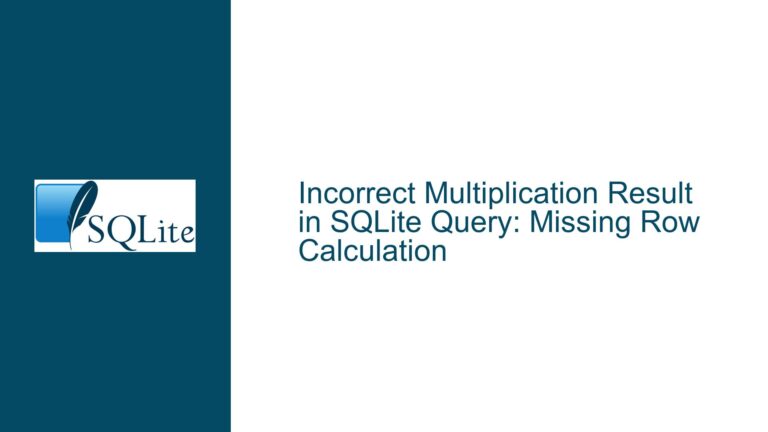Resolving Syntax Errors When Aliasing VALUES Columns in SQLite UPDATE FROM Queries
VALUES Clause Column Aliasing Limitations in UPDATE FROM Queries
Syntax Error When Aliasing VALUES Columns Inline
The core issue involves attempting to alias column names directly within a VALUES clause used in a subquery as part of an UPDATE ... FROM statement in SQLite. The original query structure works in PostgreSQL but fails in SQLite with the error:
Parse error: near "(": syntax error
FROM (VALUES (1, 'u1-x'), (2, 'u2-y')) AS "tmp"("id", "username") ) AS "t1"
error here ---^
This error occurs because SQLite does not support inline column name aliasing for VALUES clauses in the same way PostgreSQL does. The attempt to rename columns by appending ("id", "username") after the AS "tmp" alias triggers a parser error.
The goal is to update rows in a users table using a set of primary key-value pairs provided via a VALUES clause. The VALUES clause is intended to act as a transient table with explicitly named columns (id, username), allowing the UPDATE statement to reference these columns in the SET and WHERE clauses. While PostgreSQL permits column renaming directly after the VALUES alias, SQLite’s parser rejects this syntax.
The challenge lies in reconciling SQLite’s syntax rules with the desired behavior of aliasing VALUES-generated columns. Understanding this requires dissecting SQLite’s handling of VALUES clauses, its column naming conventions for derived tables, and the correct methods for explicitly defining column names in subqueries.
SQLite’s VALUES Clause Column Naming Rules and Parser Restrictions
SQLite assigns default column names (column1, column2, etc.) to rows returned by a VALUES clause when it is used as a standalone statement or within a subquery. These names are not guaranteed to remain consistent across SQLite versions or configurations, making reliance on them risky. Unlike PostgreSQL, SQLite does not provide a syntax for renaming VALUES columns directly at the point of declaration.
The immediate cause of the syntax error is the attempt to define column aliases for the VALUES clause using AS "tmp"("id", "username"). SQLite interprets this as a malformed table alias, expecting a simple identifier after AS "tmp" rather than a parenthesized list of column names. This is a deliberate parser restriction: SQLite does not implement the <table alias> (<column list>) syntax for VALUES clauses.
A deeper cause is the difference in how SQLite and PostgreSQL handle derived tables. PostgreSQL allows extensive inline transformations of subqueries, including column renaming, whereas SQLite requires column names to be defined either through explicit SELECT aliases or Common Table Expressions (CTEs). This design reflects SQLite’s emphasis on minimalism and its avoidance of syntax that could complicate the parser or increase maintenance overhead.
Another contributing factor is the ambiguity in SQL standards regarding the treatment of VALUES in derived tables. While the SQL standard specifies VALUES as a row constructor, it does not mandate support for column renaming in all contexts. SQLite adheres strictly to certain standard-compliant behaviors while diverging in others, prioritizing backward compatibility and simplicity.
Correcting Column Aliasing in VALUES Clauses for UPDATE FROM Queries
Method 1: Aliasing Columns via SELECT Clause
Instead of attempting to alias columns at the VALUES level, explicitly rename the default columns (column1, column2) in the SELECT statement that wraps the VALUES clause. This approach leverages SQLite’s ability to alias columns in the SELECT list, which is well-supported and unambiguous.
Step-by-Step Implementation:
Use the
VALUESclause as a derived table without column aliases.FROM (VALUES (1, 'u1-x'), (2, 'u2-y')) AS tmpThis creates a table
tmpwith columnscolumn1andcolumn2.Alias the default columns in the
SELECTstatement:SELECT column1 AS id, column2 AS username FROM tmpThis renames
column1toidandcolumn2tousername.Embed the aliased
SELECTin theUPDATE ... FROM:UPDATE users SET username = t1.username FROM ( SELECT column1 AS id, column2 AS username FROM (VALUES (1, 'u1-x'), (2, 'u2-y')) AS tmp ) AS t1 WHERE users.id = t1.id;Advantages:
- Avoids parser errors by using valid SQLite syntax.
- Explicitly maps
VALUEScolumns to desired names.
Risks:
- Relies on default column names (
column1,column2), which are not formally guaranteed by SQLite’s documentation. However, in practice, these names have remained consistent across versions.
Method 2: Using Common Table Expressions (CTEs)
CTEs provide a more readable and robust way to alias VALUES columns. By defining the VALUES clause within a CTE, column names can be specified upfront, eliminating reliance on default names.
Step-by-Step Implementation:
Define a CTE with explicit column names:
WITH t1(id, username) AS ( VALUES (1, 'u1-x'), (2, 'u2-y') )The
t1CTE now has columnsidandusername.Reference the CTE in the
UPDATE ... FROM:UPDATE users SET username = t1.username FROM t1 WHERE users.id = t1.id;Advantages:
- Column names are defined unambiguously.
- Eliminates nested subqueries, improving readability.
- Aligns with SQL best practices for complex queries.
Considerations:
- CTEs are optimized differently in SQLite. For small datasets, performance differences are negligible, but for large
VALUESlists, ensure the CTE does not introduce overhead.
Method 3: Combining VALUES with UNION ALL
For compatibility with older SQLite versions (pre-3.8.3, which introduced CTEs), use UNION ALL to construct a pseudo-table with aliased columns.
Step-by-Step Implementation:
Create a
SELECTstatement for each row, aliasing columns:SELECT 1 AS id, 'u1-x' AS username UNION ALL SELECT 2, 'u2-y'Each
SELECTdefines column names, andUNION ALLcombines the rows.Embed the unioned query in the
UPDATE ... FROM:UPDATE users SET username = t1.username FROM ( SELECT 1 AS id, 'u1-x' AS username UNION ALL SELECT 2, 'u2-y' ) AS t1 WHERE users.id = t1.id;Advantages:
- Works in all SQLite versions.
- Explicit column aliases in each
SELECT.
Drawbacks:
- Verbosity increases with the number of rows.
- Less efficient for large datasets compared to
VALUES.
Final Recommendations
- Prefer CTEs for clarity and maintainability.
- Use SELECT aliasing when CTEs are undesirable or when working with simple queries.
- Avoid reliance on default column names (
column1,column2) in production code unless strictly necessary.
By adhering to SQLite’s syntax rules and leveraging its support for CTEs and SELECT aliasing, developers can achieve the desired UPDATE ... FROM behavior without parser errors. These methods ensure compatibility and align with SQLite’s design philosophy while providing the flexibility needed for dynamic value-driven updates.






